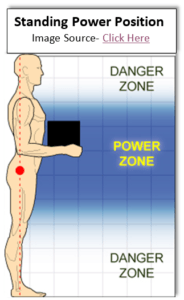
01 Oct Understanding Your Ergonomic “Power Position”
A Power Position may sound like something used by UFC Fighter, Coner McGregor, but it’s actually  something we can all use every day, including workplace athletes. It’s also not the “Power Pose” used to inspire confidence that Amy Cuddy explained during her now famous TED Talk. No, a Power Position is about ergonomics and maintaining neutral posture throughout the workday.
something we can all use every day, including workplace athletes. It’s also not the “Power Pose” used to inspire confidence that Amy Cuddy explained during her now famous TED Talk. No, a Power Position is about ergonomics and maintaining neutral posture throughout the workday.
Ergonomic risk factors are ubiquitous as most workplaces typically see soft tissue injuries and muscular-skeletal disorders typically making up 1/3 or more of workers comp claims. With October being National Ergonomic Month, it is a fitting time to discuss Power Position and how it relates to ergonomics and workplace athletes.
A Power Position is when your body is in the ideal posture to perform work. A Power Position may also be referred to as neutral posture, but it’s just not as cool sounding or memorable without alliteration. Maintaining neutral posture throughout the workday allows one’s body to be aligned and balanced, and minimizes the stress on the body by keeping joints aligned. Due to the body being in this ideal alignment, one has more control over the work they are manipulating. They are also able to apply the most force in this position in the easiest manner. See figure to right displaying Power Position.
To illustrate this point think about holding a twenty pound weight with good posture in a standing power position. Your spine is straight with your feet, hips, and shoulders aligned. You’re shoulders are back and adducted at the sides. Your elbows are bent at a 90 degree angle and the 20 pound box is held close to your body in your “Power Zone”. This is easy enough, right? Now imagine holding that same 20 pounds with arms outstretched completely and shoulders at a 90 degree angle from torso. Lifting the box in this manner is lifting in the “Danger Zone as coined by OSHA. This is the exact opposite of our Power Position and is referred to as an awkward posture. These postures deviate significantly from the power position so much so that muscles operate less efficiently and more force must be expelled to complete a job task.
In the example, the weight is easiest to lift when it is close to the body and in the power position. This is dubbed the power zone. This is a fairly obvious example, and if you saw someone holding a weight with their arms outstretched, you’d probably think this was odd behavior unless you were at your local gym on a shoulder day. On the other hand, in many workplaces, these awkward postures are easily observed and yet no one is asking “why are we doing it this way”? The response is often “we’ve always done it that way”, as if it’s the best way simply because of status quo.
To keep ergonomics simple, think about it like this- the further a workplace athlete is out of their power position and moves towards the extremes in range of motion, the more stress is placed on their muscles, bones, nerves, and tendons. Like Conner McGregor uses positioning to provide leverage on his opponent in the octagon, the workplace athlete must do the same.
The most common risk factor associated with soft tissue injuries is awkward postures. Like always, the best safety device of a workplace athlete is their brain, and those athletes who understand power position are more self-aware while performing job tasks are less likely to suffer soft tissue injuries. Train workers on ergonomic “Power Position” today.





No Comments